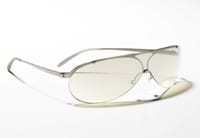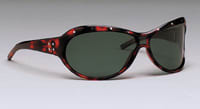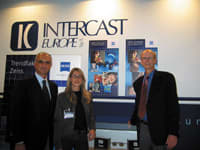MIDO
2003
Though this year's MIDO was hit hard
by outside factors, the Milan trade fair
still featured a wealth of new products,
technology, and innovation
By Erinn Morgan
The opening resembled a starting gate packed with hundreds of contenders jockeying for position--when the whistle blew, the crowd quickly poured in and dashed to their first destinations. But despite this strong start, it became apparent as the day progressed that the overall mood was subdued.
The normal Milanese hustle and bustle was a bit slower. And the number of attendees jostling about on the show floor was visibly reduced.
The 34th annual MIDO exhibition, held May 2 through 5, was hit on many fronts with outside factors that affected its attendance and mood. Despite the announced end of the war, tension continues--and many are still reluctant to travel. Poor economic factors also curtailed travel plans for businesses.
MIDO boasted more than 1,100 exhibitors (405 Italian and 713 foreign from 32 nations) and the exhibition area spanned 120,000 square meters. However, the number of attendees for the event dropped by 33.4 percent from last year with a total of 25,500 visitors, show representatives report. The drop was evidenced by the decline in the number of foreign visitors by 20.9 percent as well as 48.8 percent fewer Italian attendees.
Along with economic concerns, international conflicts, and an Italian holiday weekend, fears surrounding the spread of the SARS virus kept business travelers at home.
The concern to maintain a SARS-free environment is strong in Italy, and extra efforts were visible at the show, including extra cleaners in bathroom and conference areas. A few attendees wore face masks and some booths offered boxes of rubber gloves to their visitors.
"The Chinese group stand was cancelled after a spontaneous decision not to participate in the fair," says Cirillo
Marcolin, president of MIDO, "due to the difficulties related to applications for permission, but most of all, out of a fear of being thwarted by a limited influx
of visitors."
A number of other suppliers, as well as international buyers and opticians, also cancelled their plans for MIDO attendance. In addition, many U.S. companies cut back on the number of employees traveling to the show.
FASHION AND TECHNOLOGY SAVE FACE
The good news at the show was the wealth of new products and fashion trends that piqued buyers' interest. According to MIDO president Cirillo Marcolin, more than 200,000 new eyewear styles were on display. New lens designs and equipment technologies were abundant as well, and the fair even hosted a special MIDO Tech pavilion to house the vendors of lens processing equipment.
A handful of focused eyewear fashion trends were evident at the show--the introduction of which kept the buyers buying. Following is a rundown of the frame directions:
Rimless revision. The frame style that has taken the market by storm of late has been rethought to keep consumers coming back. Updated versions showed up in brightly colored, thin plastics that broke the minimalist barrier down in rimless styling.
While still simple because of their three-piece mounting, new zyl versions make more of a visual statement than their simply elegant metal counterparts.
Speed racer. Fashion gets sporty this season and eyewear does not miss the boat on this trend. Shields take a new tack in versions that envelope the face in a more unique way.
Flash mirrors and gradient tints are still strong, but these formerly rimless frames have been enveloped in unique treatments, such as white plastic rims or thin metal framing behind the lens.
Aviators also jump on the bandwagon this season, sporting a fashion edge in rimless versions also backed by a thin metal frame. This military-inspired frame style showed up in a variety of other new looks, from thick plastics to thin metals.
Size matters. This trend runs at opposite ends of the size spectrum. Small, vintage-inspired shapes are making a comeback in metal and plastic versions. Shapes include modified ovals and geometrics. On the other hand, oversized zyls were important in a full range of shapes and colors--from Jackie O to mod in everything from white to deep red.
Logo redux. These monikers of style also appeared in sizes both large and small on the new MIDO selections.
One trend direction has logos coming in smaller, understated versions. They may appear on the inside of a temple or the end of a temple tip. On the other end of the spectrum, logos are brazen, showing up on frames where they demand the focus of attention. They are used as design elements within the frame--for example, in rhinestones running along the temple or coming off the frame front as a three-dimensional extension of the eyewear.
Pattern maker. Less prevalent, but still important, were new patterns and prints adorning frames. Some lines featured styles with fabric laminated between clear and colored layers, creating an unusual effect. Others tied into current trends--such as military-inspired garb with camouflage-colored plastic accents.
In addition, embellishments such as small studs running across browbars or candy-colored, gem-like stones on temples created excitement in a few lines.
Lens focus. The style focus on the lens continues at a fast pace, with designers developing new schools of thought on how to cut, color, embellish, and utilize this important optical element.
Prints applied to lens fronts are creating a buzz, with versions from all-over camouflage to "tattoos" of Japanese lettering, dragons, and desert scenes at Eyers.
Another noticeable direction was that of interchangeable lenses--a feature that has been important in the sport market that has now made its way into the fashion arena. For example, the Lindberg Sirius line features modified aviator shields that come with the lens color of choice, additional colors can be purchased and the lens is easily changed.
New lens technology also hit the market at MIDO. One new product is nXt™, a lightweight, high optical quality, impact-resistant lens polymer launched by Intercast. The material was originally developed for military application as ballistic armor.
According to Intercast, nXt is 10 percent lighter than polycarbonate and has a higher impact resistance. It also has a lower refractive index and chromatic dispersion than poly, resulting in lower surface reflection and rainbowing, higher definition, and sharper colors.
The MIDO 2004 exhibition is slated for May 7 through 10 in Milan. For more information, visit www.mido.it.

|
1. Fast and sexy, the new shields feature minimal metal frames in contrasting colors are making a statement. Shown here: Stella McCartney by Sàfilo |

|
2. One of the newest innovations in the successful shield market is the interchangeable lens--frames come with a lens in the color of choice and additional colors can also be ordered. Shown here, Lindberg model SI_8510mA |

|
3. Cirillo Marcolin, president of MIDO, speaks at a press conference held to kick off the show |

|
4. Brightly colored acetate has found a home with the eyewear darling of the moment--the three-piece rimless frame. Shown here: Marcolin's Miss Sixty MX47S |

|
5. Luxottica's Guiseppe Servidori in the company's festive Ray-Ban booth |

|
6. Today's shields feature frames inside the lens, outside the lens, or both. Shown here: Prada SPR10D |

|
7. Left to right: Loh's Kurt Atchison with Peter Philipps and Manfred Hanisch in front of the company's new FreeForm Polishing machine |

|
8. Patterns and prints are making a showing in eyewear and sunwear. Shown here: Leone 704 by Viu*In Occhiali
|

|
9. REM's Mike Hundert, Donna Gindy, and Steve Horowitz at their booth |

|
10. A smartly discreet, simple side logo. Shown here: Marcolin's Dolce & Gabbana style DG465
|

|
11. Dick Russo from Sàfilo and Sergio Borsato, designer of Carerra, show off the new product in the Carerra booth |

|
12. Fabrics laminated in clear or translucent plastics create a patterned effect. Shown here, Alba 701 by Viu*In Occhiali |

|
13. Lindberg's Birgitte Stentoft and Peter Warrer kick off MIDO with the company's new frame products |

|
14. This frame has got it all--it is fashionably oversized with wrap effect in trendy tortoise and has an aviator twist. Silver studs adorning the frame are the icing. Shown here: Bottega Veneta from Sàfilo (model B.V.01/S) |

|
15. Harvey Ross, left, hosts the well-attended Viva party, with Mitch Barkley, at the Pricipe di Savoia Hotel Milan. |

|
16. The revolutionary Intercast lens material nXt™, shown here in a high-base-curve prototype frame, is reportedly lighter and stronger than polycarbonate. |

|
17. From left: Viva's Liz Tontodonati, Sue McCormack, Debbie Lochli, Lisa Cesaro, and Stacie Anderson with Claudio Arena, at the company's party |

|
18. Zyl materials punch up the minimal rimless look, taking a sophisticated style and adding a sense of humor. Shown here: Superga model Su 094 |

|
19. Mark Levinson, Diana Downs, and Adour Douvjian working hard at the Allison Eyewear booth |

|
20. An unabashedly bold logo is one of two extremes in logo-bearing eyewear. Shown here: Marcolin's Dolce & Gabbana DG443S with large logo on its lens |

|
21. Intercast's Paolo Baiocchi, Veronica Baiocchi, and Jim Pritts present the new nXt lens at MIDO |
|
Italian Eyewear Standstill |
The Italian eyewear industry has had its challenges in the past year. In 2002, Italian eyewear production totaled 1.859 million Euros, up only 1.2 percent over 2001. Export figures were 1.562 million Euros versus 1.531 million Euros in 2001, a very small increase as well. Retail fared even worse. Sales fell by 4.2 percent in 2001 and decreased from 629 million to 603 million Euros in 2002. Industry experts blame the downfall on a slump in American markets, down 16 percent in imports from Italy in 2002. "The United States (the leading export market for sunglasses and the second for frames) was the main cause for the slowdown in our exports," says Vittorio Tabacchi, president of ANFAO, the optical industry association. "Shrinking consumption in the United States has led to a reduced demand for consumer goods." On the upside, the slump in the U.S. has been slightly offset by good performance in France with Italian product (+40.6 percent), Spain (+22.3 percent), and the United Kingdom (+10.5 percent). Still, these increases have not offset the entire loss from U.S. sales. Interestingly, imports to Italy increased by 9.3 percent to 473 million Euros in 2002. This increase was in the area of sunglasses (+18.3 percent) as well as frames (+11.8 percent). Despite the multitude of anti-counterfeiting efforts ANFAO has made in recent years, some of the products imported to Italy from Asia are imitations--in 2002 alone, the Italian authorities seized more than 50,000 pairs of sunglasses. ANFAO says it expects the situation to remain the same in the first quarter of 2003 with a To help the national optical industry get a leg up on the difficult situation, ANFAO has implemented a number of special initiatives to promote Italian eyewear overseas. For example, a catwalk of Italian designers dedicated to European buyers in Paris is planned for September. In March there will be two events for the trade and U.S. buyers of fashion and accessories in New York. Lastly, an agreement has been signed with the Italian Ministry of Production Activities to plan targeted promotional activities for Italian eyewear for those international markets with the most potential, including Russia and some Eastern European countries.
|



